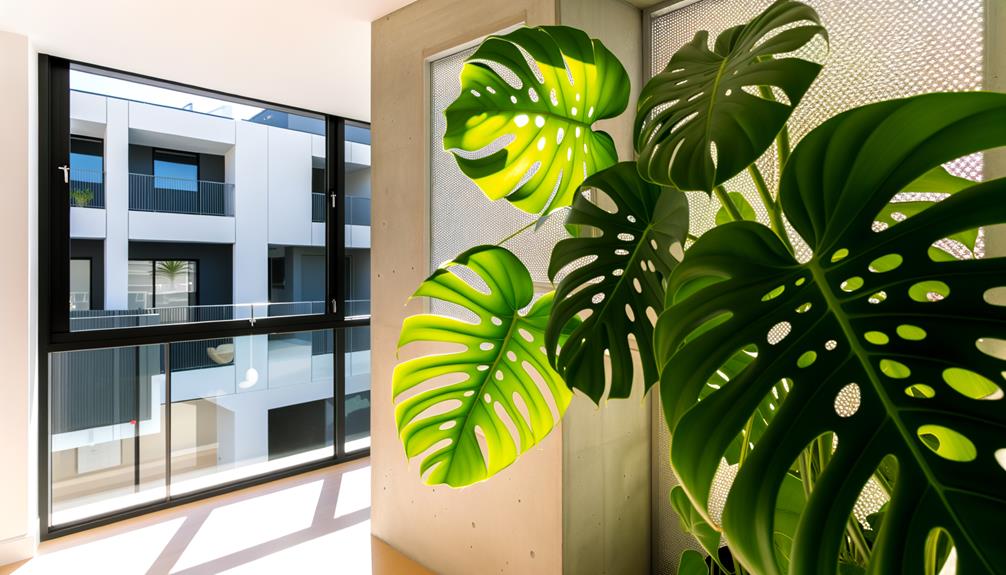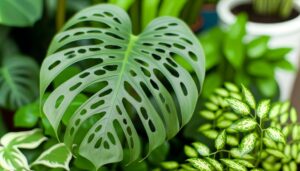Monstera Obliqua Swiss Cheese Vine Perth
You can find the coveted Monstera obliqua, known for its highly fenestrated, lace-like leaves, at specialized nurseries in Perth such as The Green Emporium and The Jungle Collective. This rare aroid requires high humidity, indirect bright light, and a well-draining substrate with a mix of orchid bark, perlite, and peat moss.
Unlike Monstera adansonii, Monstera obliqua has more pronounced leaf perforations and demands careful watering to maintain consistent soil moisture. If you want to explore its unique growing needs, proper care techniques, and why it's so sought after among collectors, there's more to discover.

Key Takeaways
- Monstera obliqua has highly fenestrated, delicate leaves with up to 90% perforations.
- Ideal growing conditions include humid environments, indirect bright light, and temperatures between 18-27°C.
- Available at specialized nurseries like The Green Emporium and The Jungle Collective in Perth.
- Regular inspections for spider mites and fungal leaf spots are essential for plant health.
- Propagate using healthy stem cuttings and maintain soil moisture without waterlogging.
Understanding Monstera Obliqua
Why is Monstera obliqua, often mistaken for Monstera adansonii, renowned for its exceptionally fenestrated leaves and delicate structure?
You'll notice its leaves are noticeably thinner and more perforated than other species. The fenestrations, or leaf holes, are so pronounced that they occupy a large portion of the leaf blade.
Monstera obliqua's delicate morphology includes a slender stem and fragile leaf tissue, making it a challenging plant to cultivate. Additionally, its internodes are longer, and the overall plant structure is more vine-like.
This species thrives in high humidity and indirect light, mimicking its native tropical rainforest understory. Understanding these characteristics helps you differentiate Monstera obliqua from Monstera adansonii, which has thicker leaves and less extensive fenestration.
Unique Features
Monstera obliqua's distinctive features include its highly fenestrated leaves, which can consist of up to 90% perforations, setting it apart from other species in the Monstera genus. These remarkable fenestrations aid in efficient light penetration and air circulation, making the plant highly effective in its natural tropical habitat. The fragile, almost lace-like quality of the leaves adds a visually striking element to any collection.
| Characteristic | Description |
|---|---|
| Fenestrated Leaves | Up to 90% perforations, maximizing light and air |
| Leaf Texture | Thin, delicate, almost lace-like |
| Growth Pattern | Vining habit, suitable for trellises or baskets |
You'll notice the obliqua's leaves have a thin texture, scientifically known as membranous, which contrasts with thicker-leaved Monstera species. This unique adaptation allows the plant to thrive in humid, low-light environments.
Differentiating From Monstera Adansonii
When distinguishing Monstera obliqua from Monstera adansonii, you'll notice that the former exhibits more pronounced leaf perforations and a thinner, more delicate membranous texture. Monstera obliqua's fenestrations often encompass a significant portion of the leaf blade, creating an almost skeletal appearance.
In contrast, Monstera adansonii, commonly known as the Swiss Cheese Plant, displays smaller and more elliptical holes. You'll also observe that Monstera obliqua has a slower growth rate and rarer occurrence in the wild, making it highly prized among collectors. Additionally, the leaves of Monstera adansonii are more robust and less prone to tearing, providing a sturdier texture.
Both species belong to the Araceae family, yet their morphological differences are quite distinct.
Ideal Growing Conditions
To maximize growth of Monstera obliqua, provide a humid environment with indirect, bright light and maintain temperatures between 18-27°C (64-81°F).
Utilize a hygrometer to monitor humidity levels, aiming for 60-80%. Place your Monstera obliqua near a north or east-facing window for prime light exposure, avoiding direct sunlight to prevent leaf scorch. Ensure the plant receives filtered light through sheer curtains or utilize grow lights if necessary.
Maintain consistent temperatures, avoiding drafts or sudden changes. The substrate should be well-draining; a mix containing orchid bark, perlite, and peat moss works effectively. Regularly check for signs of stress, such as yellowing leaves, which indicate that environmental conditions need adjustment.
Providing these conditions promotes robust, healthy growth.
Watering Needs
Proper watering is essential for Monstera obliqua, requiring a balance that keeps the soil consistently moist but not waterlogged. Overwatering can lead to root rot, while underwatering may cause leaf yellowing and wilting.
To gauge moisture levels, insert your finger about an inch into the soil; it should feel damp but not soggy. Utilize distilled or rainwater to avoid mineral buildup, as Monstera obliqua is sensitive to salts and chemicals found in tap water.
Watering frequency varies with environmental conditions; increase frequency during warmer months and reduce it in cooler periods. Make sure your pot has drainage holes to prevent water accumulation, promoting healthy root aeration.
Soil and Fertilization
Promoting optimal growth for Monstera obliqua involves using a well-draining soil mix rich in organic matter, like a blend of peat moss, perlite, and orchid bark. This combination guarantees aeration and moisture retention, vital for Monstera roots. You'll want to maintain a slightly acidic to neutral pH, around 6.0 to 7.0, to facilitate nutrient uptake.
Fertilize your Monstera obliqua during the growing season with a balanced, water-soluble fertilizer, like 20-20-20 NPK. Apply it every two weeks, but reduce frequency during dormancy in winter. Make sure you dilute the fertilizer to half-strength to avoid root burn.
Organic options, such as worm castings or compost, can also provide essential micronutrients and improve soil structure.
Light Requirements
You should provide Monstera obliqua with bright, indirect light to mimic its natural understory habitat. Direct sunlight can scorch its delicate leaves, leading to chlorosis and necrosis.
For best growth, position it near a window with filtered light or use sheer curtains.
Ideal Light Conditions
Monstera obliqua thrives best in bright, indirect light, mimicking the dappled sunlight of its native rainforest understory. You should place this tropical species, from the Araceae family, near an east or north-facing window to ensure best photosynthesis.
The filtered light helps maintain its fenestrated leaves, which are essential for efficient gas exchange and light absorption. You can use sheer curtains to diffuse intense light, preventing photoinhibition and promoting healthy chlorophyll production.
Observing the plant's leaf coloration and growth patterns will help you fine-tune its light exposure. Pale leaves indicate insufficient light, while dark green leaves with consistent perforations signal ideal conditions.
Keep in mind that artificial grow lights can supplement natural light, especially during shorter winter days.
Avoid Direct Sunlight
Direct sunlight can lead to photodamage in Monstera obliqua, resulting in leaf burn and chlorosis. These symptoms appear as brown, crunchy edges and yellowing between leaf veins.
You'll want to position your Monstera obliqua in bright, indirect light to mimic its natural understory habitat. Direct sunlight can cause quick water loss through transpiration, stressing the plant and impeding photosynthesis. Use sheer curtains to scatter light or place the plant in an east-facing window where it receives morning sun but avoids harsh afternoon rays.
If you observe signs of photodamage, relocate the plant immediately. Regularly monitor the light levels with a light meter, aiming for 100-200 foot-candles, to ensure ideal growth conditions for your Monstera obliqua.
Common Pests and Diseases
When caring for your Monstera obliqua, watch for common pests like Tetranychus urticae, which cause spider mite infestations.
You'll also need to monitor for fungal leaf spots caused by pathogens such as Septoria monsterae.
Prompt identification and treatment of these issues are essential to maintaining plant health.
Spider Mites Infestation
Spider mites (Tetranychus urticae) can wreak havoc on Monstera obliqua by causing stippling, yellowing, and eventual leaf drop if left untreated. These arachnids are incredibly small, often less than 0.5 mm, making detection challenging.
You might notice webbing on the undersides of leaves, a tell-tale sign of their presence. Their feeding punctures individual plant cells, leading to chlorotic spots that coalesce into larger damaged areas. High infestations can stunt growth and weaken the plant significantly.
To mitigate these pests, regularly inspect your Monstera obliqua using a magnifying lens. Use miticidal sprays or introduce biological controls like Phytoseiulus persimilis, a predatory mite, to manage populations. Maintaining optimal humidity levels can also deter spider mite proliferation.
Fungal Leaf Spots
Have you noticed irregular, water-soaked lesions on your Monstera obliqua leaves? These could be indicative of fungal leaf spots, a common issue for this species.
The pathogens responsible, including Colletotrichum, Alternaria, and Septoria species, thrive in humid conditions. You'll observe brown or black spots with yellow halos, which may merge, causing extensive damage.
To manage this, improve air circulation, avoid overhead watering, and remove affected leaves immediately. Applying a fungicide containing chlorothalonil or mancozeb can help control the spread.
Regularly inspect your plant for early signs of infection. Understanding these details will empower you to maintain your Monstera obliqua's health and prevent further fungal issues.
Pruning and Propagation
Pruning and propagating your Monstera obliqua, commonly known as the Swiss Cheese Vine, involves precise techniques to promote healthy growth and successful new plant development.
When pruning, use sterilized pruning shears to remove yellowing or damaged leaves, cutting just below a node. This promotes the plant to focus energy on healthy foliage.
For propagation, select a healthy stem with at least one node and aerial root. Cut just below the node and place the cutting in water or moist sphagnum moss. Keep it in indirect light and maintain high humidity to foster root development.
After roots form, transplant the cutting into well-draining soil. This method ensures robust growth and a flourishing Monstera obliqua.
Where to Find in Perth
You can frequently find Monstera obliqua, known scientifically as Monstera adansonii var. obliqua, at specialized nurseries and plant shops in Perth such as The Green Emporium and The Jungle Collective. These venues often stock rare aroids, ensuring availability of healthy specimens.
For more precise locations, consider these:
- The Green Emporium – Known for its extensive collection of tropical plants, this nursery provides detailed care instructions for Monstera obliqua.
- The Jungle Collective – Often hosts pop-up events, offering a wide range of exotic plants, including Monstera varieties.
- Plant Exchange Groups – Local enthusiast groups on social media platforms often trade or sell rare plants, including Monstera adansonii var. obliqua, facilitating access to unique specimens.
Conclusion
Caring for Monstera obliqua, often called the 'Swiss cheese vine,' in Perth requires attention to its unique features and distinct needs. Like a delicate piece of art, you must provide best watering, light, and pest control.
By differentiating it from Monstera adansonii and mastering pruning and propagation, you optimize its health and beauty. Seek local nurseries for this rare gem, and you'll cultivate a botanical masterpiece reminiscent of Eden itself.






